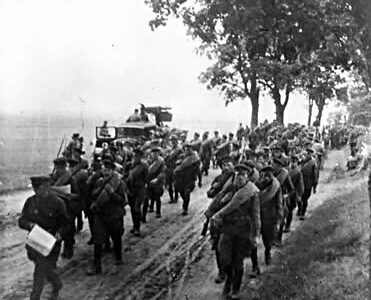Beata Bruggeman-Sekowska
The Katyn Massacre refers to the mass execution of over 20,000 Polish military officers, police officers, and intellectuals, carried out by the Soviet NKVD in 1940. This atrocity occurred after both Germany and the Soviet Union invaded Poland in September 1939: Germany attacked from the west on September 1, while the Soviets invaded from the east on September 17. In a stunning betrayal, the Nazis and Soviets had signed the Molotov-Ribbentrop Pact in August 1939, a non-aggression treaty that made them allies, coordinating their efforts to divide and conquer Poland. Two Polish sisters were murdered brutally by both totalitarian systems. Janina was executed by Soviets with a shot to the back of the head and buried in an mass unmarked grave in Katyn Forest . Her younger sister, Agnieszka, tragically shared a similar fate—executed by the Nazi Germans and buried in an mass unmarked grave, too.
The brutal reality of both regimes was clear long before the Soviets shifted their allegiance. The Soviets, quick to proclaim themselves as “liberators”, could not escape their true nature. For all their boasts, their “liberation” was a bloody occupation, as they silenced, tortured, and murdered countless Poles. Far from rescuing the Polish people from oppression, the Soviet regime—just like the Nazis—was built on a foundation of brutality and cruelty. Their “liberation” was no different than their prior role in Poland’s devastation.
For many years, the truth about the Katyn Massacre was hidden from the world, as the Soviet Union fiercely denied any responsibility and sought to cover up its involvement. The brutality of the Soviet regime extended beyond its actions on the battlefield—it was in the manipulation of history itself, erasing the truth and labeling the massacre as a Nazi crime to deflect blame. The Soviet suppression of this information, combined with their stranglehold on the media, kept the atrocity hidden for decades, allowing the world to remain ignorant of their ruthless execution of Polish officers.
While Katyn is often remembered as a massacre of men, by the Soviets in April 1940, historical records also confirm that women and even minors were among the victims. More than 50 women are now known to have been murdered in the same purge. Among them was Janina Lewandowska, the only woman identified among the officers executed in Katyn, and one of the first female POWs of WWII. Others included policewomen, prison officials, military intelligence collaborators, underground activists, teachers, aristocrats, and social workers accused of anti-Soviet activity.
The youngest of these women was 17-year-old Aniela Krotochwil, while others, like Helena Lewczanowska and Nadezhda Stepanova, were nearly 60. They were arrested between September 1939 and April 1940, interrogated in local prisons — Lviv, Lutsk, Stanisławów — and later transferred to Kyiv, Kharkiv, and Kherson. Many had children. Entire families were destroyed: mothers and daughters executed, siblings arrested, relatives deported to Siberian gulags — where many perished.
Early Life and Background
Janina Antonina Lewandowska (née Dowbor-Muśnicka) was born on April 22, 1908, in Kharkiv, Ukraine. She had two brothers and a younger sister. Raised in a household steeped in strong patriotic values, a military upbringing, and a love for music, Janina was the daughter of General Józef Dowbor-Muśnicki, renowned for his role as the supreme commander during the Greater Poland Uprising, and Agnieszka, née Korsuńska. Despite her mother’s musical talent, she had sacrificed her artistic career for her family. After several moves, Janina settled with her family in Lusowo near Poznań at the age of 10. Tragically, her mother passed away in August 1920, just a year after the youngest child in the family had been born. Nonetheless, she passed on her love of music to Janina, which later influenced her education.
Education and Career
After her mother’s death, Janina graduated from the prestigious General Zamoyska Junior High School in Poznań and went on to study piano at the National Music Conservatory. She also trained in solo singing. However, she eventually left the Lviv comedy scene, which her father disapproved of, and began working as a telegraph operator at a post office.
Janina’s determination and ambition led her to pursue a career in aviation, a passion she had since childhood. She joined the Poznań Flying Club, earning both glider and parachutist certificates. At just 20 years old, she became the first European woman to parachute from a height of over five kilometers. She also attended the prestigious Wyższa Szkoła Pilotażu at Poznań’s Ławica and was a member of the Poznań Aero Club. By 1937, she had earned her pilot’s license for light aircraft. In 1938, she moved to the Communication Training Center in Zegrze, where she trained in the operation of Hughes telegraphs—devices used for transmitting information over telegraph lines. Lewandowska also completed radio-telegraphic courses in Lviv and Dęblin. Shortly before the war broke out, Janina married pilot-instructor Mieczysław Lewandowski in June 1939. However, their happiness was short-lived.
Military Service and Capture
In August 1939, just 50 days after her wedding, Janina was conscripted into the 3rd Air Force Regiment near Poznań. She was determined to serve her country, holding a motor pilot’s diploma and being trained as a radiotelegraphist. However, her military service was cut short. After the war began, she was ordered to evacuate with her fellow airmen eastward. On September 22, 1939, she was captured by Soviet forces. On the same day, a victory parade by both the Wehrmacht and the Red Army took place in Brest.
Janina was initially sent to the camp at Ostaszków and later transferred to Kozielsk. Throughout her time in captivity, Janina remained strong and resourceful, assisting the chaplain with secret Holy Masses, singing, and even baking communion wafers. According to Major Kazimierz Szczekowski, who shared her fate, Janina was known for her immense courage.
Janina was housed in a small space under the stairs, which became a kind of refuge where she could enjoy a semblance of privacy. The space soon became known among her fellow prisoners as “Bristol” (a famous hotel).
Execution and Death
On April 22, 1940, Janina Lewandowska’s life tragically came full circle. On her 32nd birthday, she was executed by the NKVD, shot in the back of the head. She was buried in a mass grave alongside other victims of the Soviet massacre. Her name appears on the death list of prisoners from Kozielsk, numbered 0401, position 53, dated April 20, 1940. Janina was one of about 22,000 Polish citizens, including military officers, soldiers, police officers, and intellectual elites, who were murdered in the Katyn Massacre. The Soviets’ aim was to eliminate the very people who could have helped Poland function as a modern state.
The Aftermath
In 1943, during the German exhumations, Janina’s remains were found, though this information was not made public at the time. Her skull, along with those of several others, was taken to Wrocław by German forensic scientist Professor Gerhard Buhtz, who used the skulls for his scientific research. Polish Professor Bolesław Popielski, who kept this secret for many years, finally revealed the truth in 1997, and research later confirmed it.
In 2005, Janina’s remains were returned to her family and interred in the Muśnicki family tomb in Lusowo. In 2007, she was posthumously promoted to the rank of lieutenant.

The Fate of Janina’s Sister
Agnieszka Dowbor-Muśnicka, codename Gusia was born September 7, 1919 in Lusowo. In 1937, she graduated from the General Zamoyska State Gymnasium and High School. In mid-September 1939, she moved to Warsaw. At the start of the war, Agnieszka had continued the family tradition of Polish resistance by joining the Armia Krajowa (Home Army).During the occupation, she became active in the underground military organization “Wilki” (“Wolves”).
On April 25, 1940, members of her group were arrested and imprisoned in Pawiak prison. Agnieszka was among those detained, imprisoned, tortured, and ultimately sentenced to death.
She was one of the 362 people who were executed and buried in mass, unmarked graves in Palmiry on June 20/21, 1940. She is commemorated with a symbolic inscription on the family tomb at the cemetery in Lusowo. In 2017, her burial place in Palmiry was identified and her remains were confirmed.
Like Janina, she was shot in the back of the head and buried in a shallow grave—one killed by the Germans, the other by their then-allies, the Soviets.
Commemorations
- In Połczyń-Zdrój, an Oak of Memory honors Janina Lewandowska’s legacy.
- In 2015, a monument was erected in Lusów to General Józef Dowbor-Muśnicki, commemorating both of his daughters: “Janina Lewandowska, murdered in 1940 by the NKVD in Katyn, and Agnieszka Dowbor-Muśnicka, murdered by the Germans in Palmiry.”
- On March 19, 2020, the National Bank of Poland introduced a commemorative silver coin with a face value of 10 zlotys, featuring Janina alongside the word “Katyn” on one side, and Agnieszka with the word “Palmiry” on the other, to honor the two sisters.
Photo: Janina Lewandowska. Public domain. Wikipedia: Author Janusz ‘Ency’ Dorożyński. Photo of this photo taken with permission of Lusowo Museum (near Poznań) 2005-05-17. https://commons.wikimedia.org/wiki/File:JLewandowska.JPG
Photo: Agnieszka Dowbor-Muśnicka Public Domain, auithor Unknown, Tragiczne losy córek generała Dowbora-Muśnickiego. https://commons.wikimedia.org/wiki/File:Agnieszka_Dowbor-Mu%C5%9Bnicka.jpg



Follow Us!